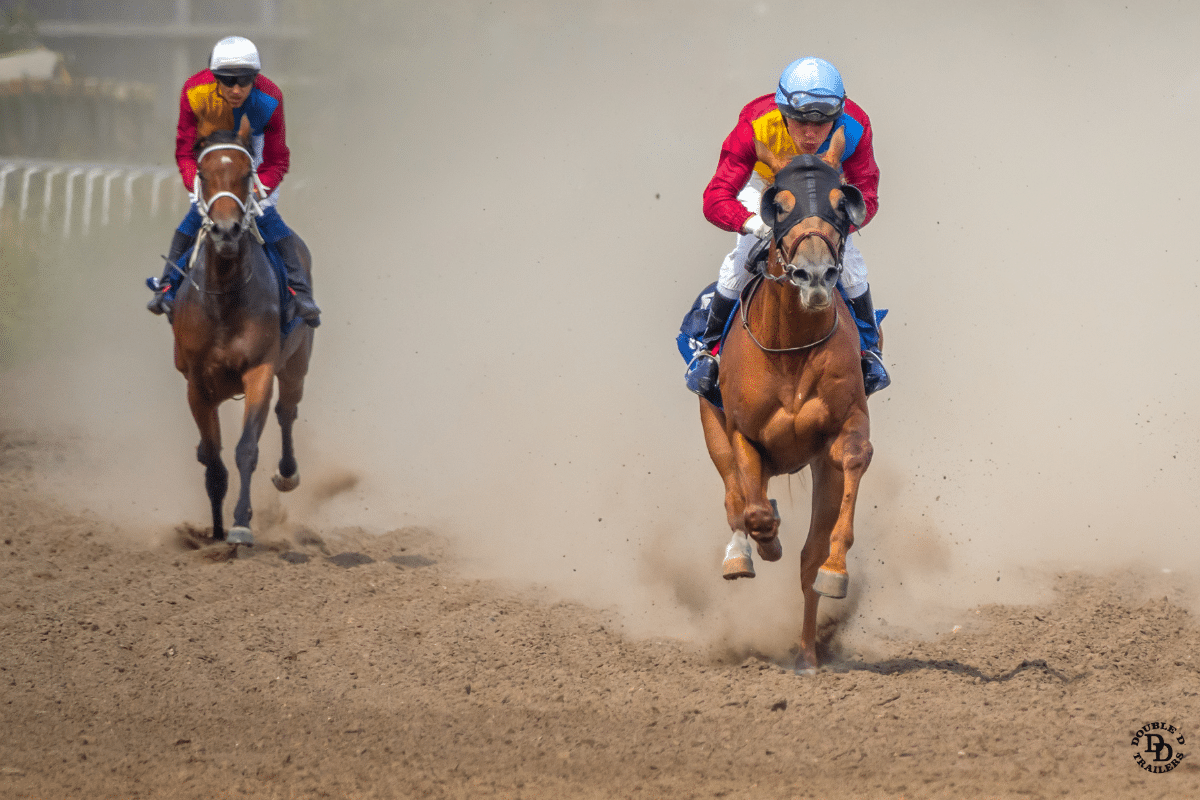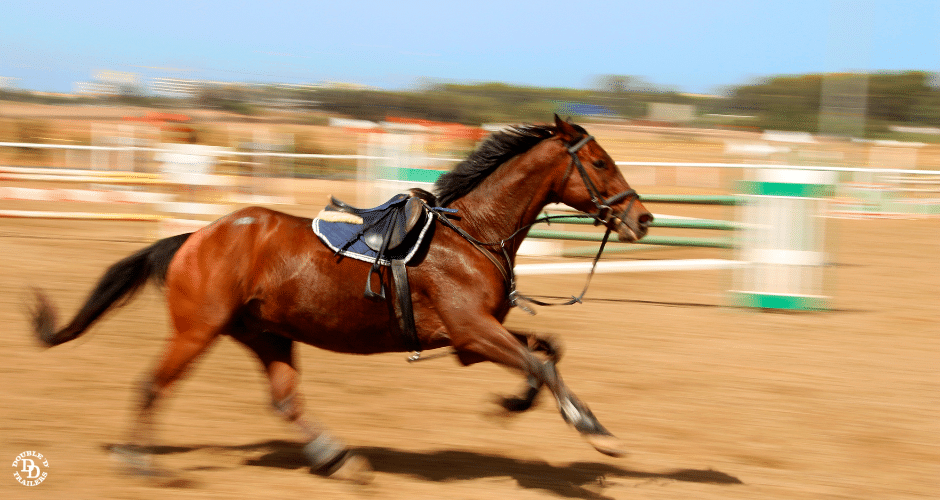Understanding Horse Racing Distances And Why They Matter for Your Horse’s Health and Travel
Horse racing is one of the oldest and most thrilling sports in the world; a showcase of speed, endurance, and sheer competitive spirit. But if you’ve ever watched a race and heard terms like “6 furlongs” or “1 ¼ miles,” you might’ve wondered what those distances actually mean, and why they matter.
In this guide, we'll break down:
- What a furlong is (and how it came to be)
- How long it takes a horse to run various race distances
- The most common race lengths (including the Triple Crown)
- And why these distances can impact how horses are transported and cared for, especially off the track
Knowing how racehorses perform over different distances gives you a better sense of what they need; not just on the track, but in the trailer, too.
What Is a Furlong in Horse Racing?
A furlong is a traditional unit of distance equal to 220 yards, or 1/8 of a mile. While it originated in agriculture, literally meaning “furrow long,” the distance a team of oxen could plow before resting, it’s now almost exclusively used in horse racing.

So when you hear that a race is “6 furlongs,” you’re looking at three-quarters of a mile. Most sprint races are measured in furlongs, while longer races use miles or fractions thereof.
Quick Math:
- 1 furlong = 1/8 mile
- 6 furlongs = 3/4 mile
- 8 furlongs = 1 mile
- 10 furlongs = 1 ¼ miles (e.g., Kentucky Derby)
- 12 furlongs = 1 ½ miles (e.g., Belmont Stakes)
How Fast Do Horses Run a Furlong?
Racehorses are remarkably fast and consistent.
- Sprinters average about 12 seconds per furlong.
- Distance runners average closer to 13–14 seconds per furlong.
That means:
- A strong 6-furlong time = 1 minute 12 seconds
- A typical 1 ¼-mile race (like the Kentucky Derby) = ~2 minutes
- Longer races, like 1 ½ miles, may take 2 minutes 30 seconds or more depending on conditions
💡 Did You Know? Horses accelerate hard out of the gate and maintain high speeds under pressure. That puts strain on joints, muscles, and respiratory systems, especially if they’re stressed before the race. That’s why professional handlers prioritize low-stress travel environments when transporting performance horses.
Most Common Horse Racing Distances (With Examples)
5 Furlongs – The Juvenile Sprint
- Distance: 5 furlongs (⅝ mile)
- Time: ~1 minute
- Used for: Young (2-year-old) horses, often early in their racing careers
- Notable race: Breeders’ Cup Juvenile Turf Sprint
These short sprints help juvenile horses build speed, focus, and confidence. They're also used to identify potential for longer-distance events later.
Related: For young or inexperienced horses, trailers with reverse-facing stall designs and wider loading zones (like the SafeTack Reverse) help reduce pre-race anxiety.
6 Furlongs – The Classic Sprint
- Distance: 6 furlongs (¾ mile)
- Time: ~1:10 to 1:12
- Notable record: Twin Sparks, 1:06.49 (2009)
- Example race: Best Pal Stakes (Del Mar, CA)
This is a popular distance for seasoned sprinters or older horses returning from layoffs. It requires explosive speed but also rhythm and tactical jockeying.
1 Mile – The Classic Middle Distance
- Distance: 8 furlongs (1 mile)
- Time: ~1:34 to 1:40
- Record: Mandurah, 1:31.23 (2010, on turf)
One-mile races balance stamina and speed, and are often used to prep horses for even longer races. It’s also the minimum distance considered a “route” in North American racing.
1 ¼ Miles – The Kentucky Derby Distance
- Distance: 10 furlongs (1 ¼ miles)
- Time: ~2 minutes
- Kentucky Derby record: Secretariat, 1:59.40 (1973)
This is the first leg of the Triple Crown, and arguably the most famous horse race in the world. The large field size (up to 20 horses) and sheer pace make it uniquely demanding.
Fun Fact: Secretariat didn’t just win the Derby, he ran each quarter-mile faster than the last, a near-impossible feat of accelerating endurance.
1 ½ Miles – The Belmont Stakes
- Distance: 12 furlongs (1 ½ miles)
- Time: ~2:25
- Known as: “The Test of the Champion”
- Longest Triple Crown race
This race pushes 3-year-olds to their physical limit, especially after a grueling spring campaign. It's where the dream of a Triple Crown either comes alive or falls apart.
Stress Matters: Long-distance races require significant recovery time. That’s why elite barns use trailers with proper stall width, airflow systems, and rubberized flooring to reduce post-race inflammation. Learn how Double D Trailers are built with these features in mind →
Triple Crown Summary: U.S. Premier Races
| Race | Distance | Furlongs | Track Surface | Typical Time |
| Kentucky Derby | 1 ¼ miles | 10 | Dirt | ~2:00 mins |
| Preakness Stakes | 1 3/16 miles | 9.5 | Dirt | ~1:55 mins |
| Belmont Stakes | 1 ½ miles | 12 | Dirt | ~2:25 mins |
Why It Matters: The Triple Crown races take place within 5 weeks, meaning racehorses must recover, travel, and perform at top level with minimal downtime. Transporting horses safely and comfortably during this period is absolutely critical.
Why Horse Racing Distances Matter Beyond the Track
Understanding horse racing distances helps you appreciate the sport, but it also offers insight into how horses move, perform, and recover.
And for horse owners, whether you ride casually or competitively, that matters when you’re choosing:
- How far to haul your horse
- What type of trailer to use
- What stall layout supports your horse’s natural instincts
At Double D Trailers, we design custom horse trailers that prioritize safety, airflow, and reduced stress, the same factors that top trainers look for when hauling performance horses across the country.
Explore our reverse slant load trailers and discover how smarter design supports healthier, happier horses.
Frequently Asked Questions
How long is a furlong in horse racing?
A furlong is 1/8 of a mile, or 220 yards. It’s the traditional unit used for measuring short and mid-distance horse races.
What are the most common horse racing distances?
Standard race distances include:
- 5 furlongs – juvenile sprints
- 6 furlongs – classic sprint
- 8 furlongs – 1 mile
- 10 furlongs – 1¼ miles (Kentucky Derby)
- 12 furlongs – 1½ miles (Belmont Stakes)
How fast does a racehorse run per furlong?
Top racehorses average 12 seconds per furlong in sprint races. For longer races, the pace slows slightly to about 13–14 seconds per furlong.
What’s the difference between a sprint race and a route race?
A sprint is any race under 1 mile (less than 8 furlongs). A route is 1 mile or longer. Sprints emphasize speed, while routes test stamina and pacing strategy.
What’s the length of each Triple Crown race?
- Kentucky Derby – 1¼ miles (10 furlongs)
- Preakness Stakes – 1 3/16 miles (9.5 furlongs)
- Belmont Stakes – 1½ miles (12 furlongs)
What’s the longest horse race in the world?
The Mongol Derby is the longest, spanning about 620 miles across Mongolia. In the U.S., endurance-style races like the Belmont Gold Cup (2 miles) are among the longest regulated events.
How do race distances affect how horses are trained?
Sprinters focus on high-intensity bursts, while distance horses undergo endurance conditioning. The race length also impacts how horses recover and how they should be transported before and after events.
What’s the average recovery time after a major race?
Recovery time can range from 5 to 14 days, depending on the race length, track surface, and exertion. Triple Crown contenders are especially affected due to short recovery windows between races.
How do racetrack surfaces affect horse performance?
Dirt tracks are typically the fastest, followed by synthetic surfaces, with turf being the slowest. The surface also affects concussion and recovery, one reason shock-reducing trailer flooring can help protect horses post-race.
Why does understanding race distances matter for horse owners?
Race distances reveal how horses respond to physical stress and fatigue, critical insights when hauling horses. The right trailer design (stall layout, airflow, flooring) supports safer, more comfortable travel, whether for racing, breeding, or pleasure riding.
Final Thoughts
From the 5-furlong juvenile sprints to the grueling 1 ½-mile Belmont Stakes, every horse racing distance presents a unique challenge, not just for the horse, but for their care team and travel setup, too.
If you’re responsible for transporting horses, whether for racing, breeding, or trail riding, the lessons of the racetrack still apply:
- Comfort reduces stress
- Design affects performance
- And the right trailer can make all the difference
Explore Custom Horse Trailers That Put Your Horse First →


